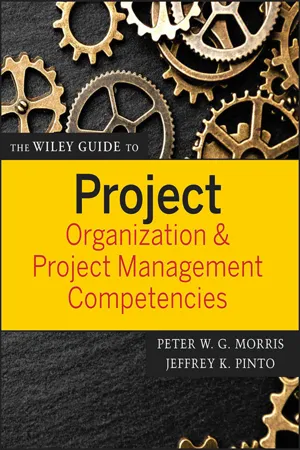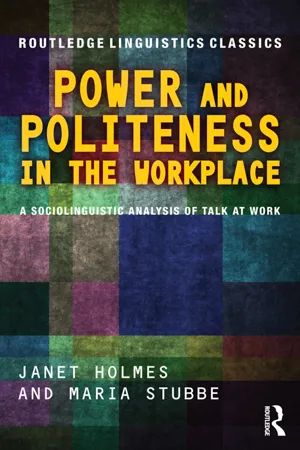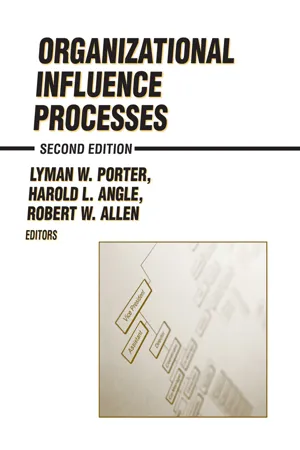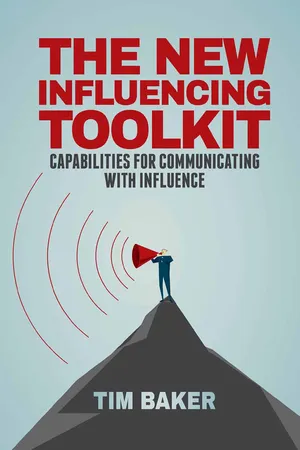Business
Power in Work
Power in work refers to the ability of individuals or groups to influence or control resources, decisions, and outcomes within an organization. It can be derived from various sources such as expertise, formal authority, control over information, or personal relationships. Understanding power dynamics is crucial for effective leadership, teamwork, and organizational success.
Written by Perlego with AI-assistance
Related key terms
8 Key excerpts on "Power in Work"
- eBook - ePub
- Anthony Walker(Author)
- 2015(Publication Date)
- Wiley-Blackwell(Publisher)
It is important to distinguish between authority and power in organisations. Power is a much broader concept than authority (Weihrich & Koontz 1993) and many pages have been devoted to its definition. Many stem from Weber’s (1947) definition that ‘power is the ability of a person to carry out his own will despite resistance’. Hence ‘the ability of individuals or groups to induce or influence the beliefs or actions of other persons or groups’ (Weihrich & Koontz 1993), ‘the capacity of individual actors to exert their will’ (Finkelstein 1992) and the simple definition ‘the ability to get things done’ (Kanter 1983) used by Lovell (1993) which he believes has a significant appeal in relation to the role of project managers.Emerson (1962) expresses power from a different perspective by saying that ‘power resides implicitly in the other’s dependence’, that is control over what the other finds important to him or her. Scott (1992b) believes that Emerson’s approach means that power is not to be viewed as a characteristic of an individual but as the property of a social relation. The social relation is defined by dependency. When one person is dependent on another person, that person gains power over them (Robbins 2005). This means that in defining the power of an individual it is necessary to specify over whom he or she has power. That is, an individual cannot have power generally. Nevertheless, the possession of power is generalised by Pfeffer (1992) in defining power as ‘the potential ability to influence behaviour, to change the course of events, to overcome resistance, and to get people to do things that they would not otherwise do’. He sees organisational politics as the exercise or use of power. That is, politics and influence are the processes, actions and behaviours through which this potential power is utilised and realised. - Peter W. G. Morris, Jeffrey K. Pinto, Peter Morris, Jeffrey K. Pinto(Authors)
- 2010(Publication Date)
- Wiley(Publisher)
Power is simply the ability to get activities or objectives accomplished in an organization the way one wants them to be done. Among the key activities that power enables us to achieve are the ability of affect decisions and control resources (Dubrin, 1995). Some definitions of power set it up as a confrontational issue; for example, the belief that power implies forcing someone to do something that they would not ordinarily do otherwise. Other definitions are more benign, stating that power is simply the mechanism to positively affect a project team’s natural inertia. Underlying all these definitions of power is the belief that power “enables” some members of the organization to pursue objectives. Whether those objectives are for the good of the organization as a whole or are purely self-centered is another issue. Nevertheless, as part of any discussion of the project management process, it is important to understand the nature of power in our organizations, its various bases, how one gets and holds of power, and its potential effects on power holders.Sources of Power
There are many different ways in which individuals can acquire power within organizations. The types of power individuals choose to exercise depend, in large degree, upon the types of people they are, the opportunities available to them, and the companies they work for. Sometimes, gaining power is merely the result of luck or fortunate circumstances. To understand how each of us may acquire power, it is necessary to consider some of the more common sources of power and the reasons why they exist. Table 5.1 gives a list of some of the more common types of power routinely found in organizations.Positional Power.- Kevin Orr, Sandra Nutley, Shona Russell, Rod Bain, Bonnie Hacking, Clare Moran(Authors)
- 2016(Publication Date)
- Routledge(Publisher)
4 Power, Knowledge and Practice
Christopher Mueller, Alina Baluch and Kevin OrrDOI: 10.4324/9781315674025-4Introduction
Power relations are an integral part of our everyday lives. We have all exercised power, just as we have experienced it. Sometimes this occurs in the most mundane ways—we may have made colleagues work long hours by calling a snap meeting at five p.m., or been compelled by a deadline to spend weekends welded to a laptop. Power is often seen “as the capacity of individuals to exert their will over others” (Huzzard 2004 :353)—and, if required, to do so against their will (Weber 1954 ; Hardy & Clegg 2006 ). In this way, for example, employees must submit to a controlling performance appraisal regime. Power can also be an enabling aspect of organisational life—for example, a team leader may create an environment of openness during a project meeting, encouraging colleagues to speak candidly; a decisive intervention in a process may free up time or create autonomy; or an individual may be given more decision-making power as part of their personal or professional development. Such examples have nothing grandiose about them; they do not involve heroic deeds or the majestic wielding of power. Instead, they highlight the commonplace nature of power relations: power is an everyday phenomenon.Just as power is an integral part of our day-to-day interactions, it is at the same time deeply entwined with knowledge. Drawing on the examples above, employees must know how to conduct themselves in relation to the performance management norms of the organisation. Relations of power may also regulate access to knowledge, including one participant but excluding another. The team leader giving voice to colleagues during a meeting is inclusive and thus open towards knowledge arising through interactions in the team.This chapter begins by providing an overview of the different ways power has been understood. We then consider the relationship between power and knowledge. Following this, we use a practice-theory lens to demonstrate the fruitfulness of viewing power, knowledge and practice in conjunction with each other. Finally, we offer some thoughts about the implications of these connections for practitioners.- Ronald E. Riggio, Stefanie K. Johnson(Authors)
- 2022(Publication Date)
- Routledge(Publisher)
In sum, the different power bases indicate that power can indeed take many forms and arise from many sources. For example, expert power and referent power reside within the individual and, thus, are forms of individual power. More often than not, legitimate, reward, and coercive power are derived from organizational rather than personal sources and, thus, are types of organizational power. As you might expect, the various power bases can combine to further increase an individual’s power in an organization. At the same time, possession of certain power bases, coupled with the effective use of influence tactics (e.g., assertiveness, ingratiation, upward appeals), can even further increase the power an individual wields in a group or organization (Brass & Burkhardt, 1993). A great deal of research has been conducted on power dynamics, or on how the different power bases operate in work settings and how they affect work outcomes. Let’s explore power dynamics in work organizations.Stop & Review Name and describe three influence tactics identified by Cialdini.Power Dynamics in Work Organizations
The topic of Power in Work settings is an important one, and research on the topic has increased, particularly on the dynamics of Power in Work organizations (Tarakci et al., 2016). For example, researchers have investigated such issues as the distribution of power in organizations, the attempts of organizational members to increase power, power and dependency relationships, and the effects of power on important organizational outcomes, specifically job performance and satisfaction.Differences in Power Distribution
We know that power, because of its many forms, is unevenly distributed in work settings. Usually, organizations are arranged in a power hierarchy, with people at the upper levels possessing great power and those at the bottom having relatively little power. However, individual differences in the expert and referent power bases ensure that no two people, even those at the same status level, have exactly equal power. Therefore, although persons high in the hierarchy tend to possess more power than those at lower levels, even a low-ranking member can wield considerable power because of personal sources of power, such as expert power and referent power.- eBook - ePub
Power and Politeness in the Workplace
A Sociolinguistic Analysis of Talk at Work
- Janet Holmes, Maria Stubbe(Authors)
- 2015(Publication Date)
- Routledge(Publisher)
From a sociological or psychological perspective, power is treated as a relative concept which includes both the ability to control others and the ability to accomplish one’s goals. This is manifest in the degree to which one person or group can impose their plans and evaluations at the expense of others. 3 A more anthropological and social constructionist perspective extends this potential influence to embrace definitions of social reality (Gal 1995). Language is clearly a crucial means of enacting power, and equally a very important component in the construction of social reality. A social constructionist approach analyses every interaction as involving people enacting, reproducing and sometimes resisting institutional power relationships in their use of discourse by means of a range of coercive and collaborative strategies (e.g. Crawford 1995; Davies 1991; Dwyer 1993; Fairclough 1989; Ianello 1992). Power in the workplace may be manifested in a number of ways. In Example 1.1, Clara’s authoritative position enabled her to define the rules which others were obliged to follow. But the linguistic manifestation of power need not be so blatant - eBook - ePub
Power in Business Relationships
Dynamics, Strategies and Internationalisation
- Dariusz Siemieniako, Maciej Mitręga, Hannu Makkonen, Gregor Pfajfar(Authors)
- 2022(Publication Date)
- Routledge(Publisher)
1Power as the cornerstone of business relationshipsDOI: 10.4324/9781003095934-21.1 Multifaceted power as a key building block of business relationships
1.1.1 Introduction
The power concept has played a central role in the development of marketing thought from early research on power in marketing channels (Gaski, 1984, 1986; Lusch, 1976; Siemieniako et al., 2021) and purchasing (Bonoma, 1982; Kraljic, 1987) to a more recent approach picturing power as a general phenomenon in inter-organisational relationships (see Meehan & Wright, 2012; Cowan et al., 2015; Johnsen et al., 2020). However, the literature on power in inter-organisational structures is deeply rooted in theories about power in society in general, which would seem to be highly appropriate as inter-organisational relations are embedded within wider social structures, and the demarcation between these two is always problematic (Czernek-Marszałek, 2020; Hagedoorn & Frankort, 2008; Ratajczak-Mrozek, 2017). In this chapter, we briefly present the meaning of power and its evolution in business-to-business literature, while at the same time we show how this meaning relates to the wider discourse in the social sciences.1.1.2 Power and power sources in business relationships
The literature recognised early on that power goes beyond physically enforcing the actions of one person over another, and recognised the multifaceted nature of power in social relations. French and Raven (1959) proposed analysing power using several different types of power, that is reward, coercive, legitimate, referent and expert, while each of these “power sources” represent the potential for influencing the other actor. In 1965, this categorisation was enriched by a sixth source of power, namely informational power (Raven, 1965). French and Raven (1959) perceived power as a change in an actor’s behaviour or beliefs that result from the actions of another actor (French & Raven, 1959; Raven, 1965). The initial proposal by French and Raven (1959) has been revisited, and as a result certain specific variations of power bases have been proposed, such as personal and impersonal forms of coercion and reward, positive and negative forms of expertise and reference, as well as contract-based or norms-based legitimate power (Raven, 1992). Numerous further studies on inter-organisational relations using French and Raven (1959) categorised power sources into two groups; coercive and other power sources, in which expert, referent, legitimate and reward power were classified as non-coercive (e.g. Cowan et al., 2015; Frazier & Summers, 1984; Handley & Benton, 2012; Wilkinson, 1973; Wilkinson, 1996; Siemieniako & Mitręga, 2019). In a similar spirit, power sources were also divided into mediated and non-mediated power (Nyaga et al., 2013; Benton & Maloni, 2005; Siemieniako & Mitręga, 2019). In this second typology, the mediated power sources, that is legitimate, coercive and reward, are sometimes treated as negative forces that restrict the development of relationships (Benton & Maloni, 2005; Siemieniako & Mitręga, 2019). The distinct concepts of power based on French and Raven’s (1959) proposal and further developments are presented in brief in Table 1.1 - eBook - ePub
- Robert W. Allen, Lyman W. Porter, H.L. Angle(Authors)
- 2016(Publication Date)
- Routledge(Publisher)
We are profoundly ambivalent about power (Pfeffer 1992) and that ambivalence has led to recurrent questioning of the concept and its definition. Illustrating the pervasiveness of the ambivalence, Kanter noted, “Power is America’s last dirty word. It is easier to talk about money—and much easier to talk about sex than it is to talk about power” (1977, p. 65). John Gardner wrote, “In this country … power has such a bad name that many good people persuade themselves they want nothing to do with it” (1990, p. 55). Gandz and Murray, from a survey of 428 managers, provided empirical evidence of the ambivalence: although the managers overwhelmingly agreed with the statements “the existence of workplace politics is common to most organizations” and “successful executives must be good politicians,” they also thought that “organizations free of politics are happier than those where there are a lot of politics” and “politics in organizations are detrimental to efficiency” (1980, p. 244).After first considering the definition of power and issues of its measurement, we address three fundamental questions concerning power in organizations: (1) under what circumstances are power and influence more important in organizational decision making, and under what circumstances are political skills less critical for getting things done? (2) what are the important sources of power? and (3) what are the strategies and tactics through which interpersonal influence is developed and exercised and power gets employed?THE DEFINITION AND CRITIQUE OF THE CONCEPT OF POWER
Wrong defined power as the “intentional and effective control by particular agents” (1968, p. 676), a definition closely related to that offered by Russell: “the production of intended effects by some men on other men” (1938, p. 25). There are three key elements in the definition: the influence of some over others, the fact that power is not relegated to relations between superiors and subordinates but includes interactions among equals as well, and the idea that this influence is conscious and intended. Because of the concept of intent, Wrong saw power as narrower in its definition than the broader idea of social control: “When social controls have been internalized, the concept of power is clearly inapplicable. … We must distinguish the diffuse controls exercised by the group over socialized individuals from direct, intentional efforts by a specific person or group to control another” (1968, p. 676). - eBook - ePub
The New Influencing Toolkit
Capabilities for Communicating with Influence
- T. Baker(Author)
- 2015(Publication Date)
- Palgrave Macmillan(Publisher)
How can a manager increase their power? All managers have three spheres of influence they need to exercise in organizations. They need to be able to influence their boss on a pretty regular basis. Managers also need to exercise influence over their colleagues in other departments from time-to-time. And finally, the majority of a manager’s time is taken up influencing their employees. The ability to exercise power and influence fittingly is the lifeblood of management. To understand what exercising appropriate managerial influence means, it might be useful to start with what it shouldn’t mean. It is not uncommon to consider influence or power as a form of manipulation. Some may think that by influencing people, we are exploiting them; getting them to do something by being deceptive or cunning, underhanded or tricky. As an extension of this idea, people of influence are oftentimes considered immoral or corrupt. This idea is not what The New Influencing Toolkit is about. I want to make that clear from the outset. Influence is defined in many ways. And the concept of influence has changed throughout the ages. AT THE COAL FACE. . . THE EVOLUTION OF INFLUENCE The word “influence” comes from the Medieval Latin word influential, stemming from the Latin word influere, which means “to flow”. In the late fourteenth century, an astrological connection continued with the word being defined as “streaming ethereal power from the stars acting upon character or destiny of men”. Later, in the fifteenth century, the word had evolved into a closer version of today’s definition: “exercise of personal power by human beings”. In the 1580s, the meaning became “exertion of unseen influence by persons”
Index pages curate the most relevant extracts from our library of academic textbooks. They’ve been created using an in-house natural language model (NLM), each adding context and meaning to key research topics.







